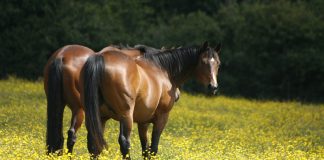How do you know if your horse is too fat, too thin, or just right? The Henneke Body Condition Score (BCS) system assigns a value from 1 (extremely emaciated) to 9 (extremely obese). Most horses are considered healthy at a score of 4 to 7. Watch the video below to find out how to judge a horse’s body condition.
| 1. Poor: Extremely emaciated; bone structure of withers, shoulders and neck easily noticeable; no fatty tissue can be felt 2. Very Thin: Emaciated; withers, shoulders and neck bone structure faintly discernible 3. Thin: Slight fat layer over ribs but ribs easily discernible; withers, shoulders and neck blend smoothly into body 4. Moderately Thin: Faint outline of ribs discernible; withers, shoulders and neck blend smoothly into body 5. Moderate: Back has no crease or ridge; ribs not visually distinguishable but easily felt 6. Moderately Fleshy: May have slight crease down back; fat over ribs spongy; beginning of fat deposits along the side of the withers, behind shoulders and along sides of neck 7. Fleshy: May have crease down back; individual ribs can be felt, but noticeable filling between ribs with fat; fat deposited along withers, behind shoulders and along neck. 8. Fat: Crease down back; difficult to feel ribs; areas along withers and behind shoulders filled with fat; fat deposited along inner thighs 9. Extremely Fat: Obvious crease down back; patchy fat appearing over ribs; bulging fat along withers, behind shoulders, along neck; flank filled in with fat. |






Thanks for the information.
good info, but I have a horse that is thinner than the thin horse. She could be rated as a 1.
Very good information and gorgeous horses. It would have been helpful to see them all in a comparison of each other. 🙂
It was informative. Good information to know.
very helpful and informative!
Excellent info.
I used to have a pony that was at least a 10! He stayed so fat just on pasture.
Very good, like the way they show you different horses to access.
Very good information. Gonna go and check my two now.